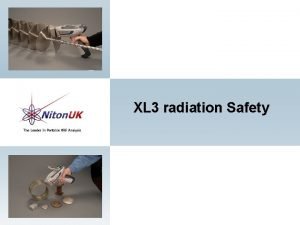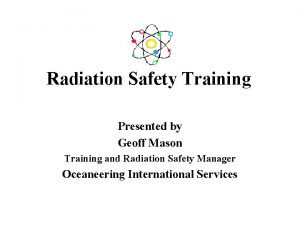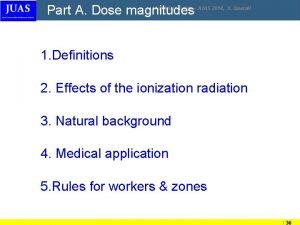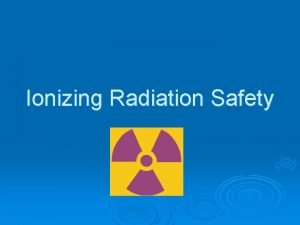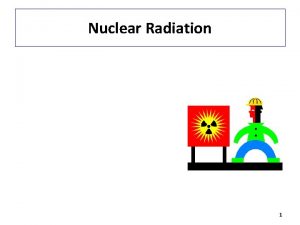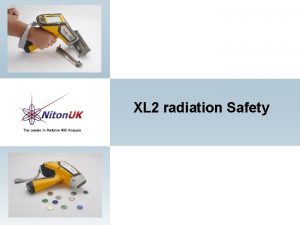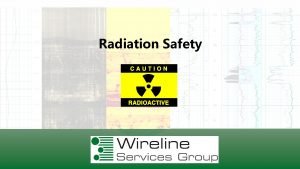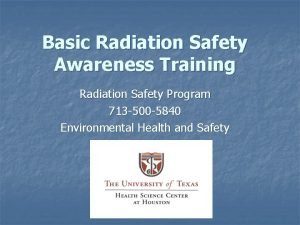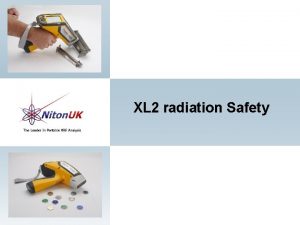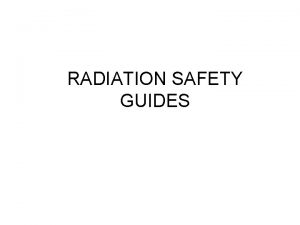Radiation Safety RADIATION ORIGINS Radiation comes from many








































- Slides: 40

Radiation Safety

RADIATION ORIGINS • Radiation comes from many sources • Manmade and natural • Natural – Terrestrial – Cosmic interactions – Internal our tissues contains radionuclides we ingest or inhale

RADIATION ORIGINS • Manmade – We make it – Products contain radioactive material – Air travel – Nuclear weapons, power – Medical • Most of manmade comes from

• Put things into perspective • We are exposed naturally • BUT need to protect ourselves because we have increase exposure potential

What are X-Rays? ● X rays are a form of electromagnetic radiation ● Arise as electrons are deflected from their original paths ● X rays are capable of traveling long distances through air and most other materials ● X rays require shielding to reduce their intensity ● X rays originate in the electronic shell (remember the electrons around the nucleus)

Causes of Exposure ● Exposure to the Primary Beam ● Exposure from secondary scatter radiation caused by interaction of the primary beam with objects in its path ● Exposure from ”leakage” radiation from the x-ray tube housing

Exposure to the Primary Beam ● At no time should any part of your body be exposed to the primary beam even if that part of your body is covered by protective clothing

Exposure due to Scatter Radiation ● known as secondary radiation •

Exposure due to Scatter Radiation ● The amount of scatter is dependent on:

Exposure due to Scatter Radiation ● Scatter is produced in all directions and travels in straight lines.

Exposure due to Scatter Radiation ● Careful collimation, and correct k. Vp settings will help reduce scatter ● Look away from the primary beam to reduce exposure to the lens of the eye ● Do not lean over the animal ● Always wear lead shielding ● Use chemical restraint as necessary Utilize positioners

Radiation From X-ray Tube Housing ● Current regulations for the manufacturing of x-ray tubes requires sufficient shielding to minimize exposure to personnel and patients ● Many veterinary clinics use older equipment with minimal shielding ○ If this is of concern, the x-ray tube should be checked by the state department of health

Radiation Exposure Units ● Unit of absorbed dose: ● Gray (Gy) ● Rad

Radiation Exposure Units • Unit of dose equivalent: • Each type of radiation has a quality factor (QF) – Reported as Rem (roentgen equivalent man) or Sieverts – Dose equivalent (rem or Sv)=absorbed dose (Gy or rad)x QF

ALARA (As Low As Reasonably Achievable) ● An ongoing series of decisions about possible radiation protection action ○ Eg: using positioning devices or chemical restraint to reduce exposure to personnel ○ You should always be thinking about how to reduce your exposure

Radiation Injury • Radiation damages cells by disrupting vital molecules • Dependent upon

Radiation Injury • Dependent upon – Sensitivity of body cells

Biological Effects of Ionizing Radiation ● There are two types of radiation damage ○ Somatic ○ Genetic

Biological Effects of Ionizing Radiation ● Due to the transfer of energy to the tissue as radiation interacts with the body ● There is a localized release of large amounts of energy ● The total energy absorbed is important, but not so critical as the size of the individual packets of energy received

Biological Effects of Ionizing Radiation ● Somatic Damage ○ Describes damage to the body that may not be apparent for some time but does manifest itself during the recipients lifetime ○ Sometimes this damage may never become apparent because the body may repair itself ○ Different cell types have different sensitivities and abilities to heal

Biological Effects of Ionizing Radiation ● Genetic Damage: ○ Results from injury to the genes (DNA) of reproductive cells ○ These injuries do not show up until the damaged individual reproduces and the mutated genes create a child ○ Gene mutations

Radiation Protection – Time The dose of radiation a worker receives is directly proportional to the amount of time spent in a radiation field.

Radiation Protection-Distance Radiation exposure decreases rapidly as the distance between the worker and the X-ray device increases. The decrease in exposure from a point source, such as an X-ray tube, can be calculated by using the inverse square law.

Inverse Square Law This law states that the amount of radiation at a given distance from a point source varies inversely with the square of the distance. .

● twice the distance from an x-ray tube will reduce the dose to one-fourth of its original value (1/2 x 2) ● increasing the distance by a factor of three will reduce the dose to one-ninth of its original value (1/3 x 3) ● IF you go 10 xs as far away you decrease your dose becomes 1/100 th of its original value (1/10 x 10)

Inverse Square Law Maintaining a safe distance, therefore, represents one the simplest and most effective methods for reducing radiation exposure.

Radiation Protection - Shielding Radiation exposure to personnel can also be reduced by placing an attenuating material between a worker and the x-ray tube. Thus, substances such as lead, that are very dense and have a high atomic number, are very practical shielding materials because of the abundance of atoms and electrons that can interact with the xray photon. Shielding is often incorporated into the equipment, such as the metal lining surrounding the x-ray tube. It may also consist of permanent barriers such as concrete and lead walls, leaded glass, and plastic movable screens.

Protective Apparel • Perform visual inspections • Perform radiographic inspections – AAHA requires • Store apparel correctly – Hang up don’t fold

How Much is Too Much? ● Maximum Permissable Dose (MPD) ● An amount of irradiation that does not involve a risk to the health of radiation workers so great that it significantly influences future generations or the individuals occupationally exposed

Maximum Permissible Dose (MPD) ● Occupationally exposed individuals older than 18, can receive up to 0. 05 Sv = 5 rems/year. ● Non-occupationally exposed persons can receive 0. 001 Sv = 0. 1 rem/year. ***No person under 18 may enter a radiographic suite unless ordered by a medical doctor

Personnel Monitoring Devices ● Dosimeters should be worn by personnel at all times during radiographic procedures

Personnel Monitoring Devices ● Types: ○ Film Badge- piece of film inside that is developed ○ Thermoluminescent dosimeter (TLD) ○ crystals absorb radiation when heated emit light , more light = more radiation ○ Optically stimulated luminescence ○ Pocket ionization chamber ○ most complex ○ read after each procedure

Personnel Monitoring Devices • Wear badge up around head/neck area • Care

Limiting your Exposure • • • ALARA Time Distance Shielding Take care of PPD and badges

Limiting your Exposure ● Radiation Safety Rules ○ Remove all unnecessary personnel from the radiographic suite ○ Never permit persons under the age of 18 or pregnant women in the radiographic suite when in use ○ Rotate personnel who assist in radiographic procedures to minimize exposure

Limiting your Exposure ● Radiation Safety Rules Use mechanical restraints whenever possible Use chemical restraint whenever possible Always wear protective apparel Wear film badges near the collar outside the lead apron to monitor radiation exposure to the thyroid gland, face, and eyes ○ Plan the radiographic procedure carefully to avoid the need for retakes ○ Maintain darkroom chemicals in good operating condition ○ Have the x-ray machine calibrated annually by a qualified expert ○ ○

Limiting your Exposure ● Radiation Safety Rules ○ Have an adequate technique chart ○ Use positioning aids ○ Quality control measurements and tests are performed ○ Remember that patience is an important virtue!

Limiting your Exposure ● Radiation Safety Rules ○ Never permit any part of the body in the primary beam ○ Use collimation whenever possible to decrease field size and scatter radiation ○ Never handhold the x-ray tube

Radiation Safety and pregnancy • Fetus particularly susceptible first 4 months • Is it ok to continue taking radiographs? – Million dollar question with no clear answer • MPD is lower for pregnant women – What if they need radiographs/CT for their own health reasons? • Probably best to not take radiographs

Radiation safety and pregnancy • What to do when you find out you are? • Alert your supervisor maybe in writing • Should look at your most recent dosimeter report • If opt to continue to perform radiology
 First comes love, then comes marriage
First comes love, then comes marriage Radiation safety
Radiation safety Geoff mason
Geoff mason Radiation safety
Radiation safety Tungsten inclusion in rt film
Tungsten inclusion in rt film Many sellers many buyers
Many sellers many buyers E r diagram
E r diagram Convert conceptual model to logical model
Convert conceptual model to logical model Unary many to many
Unary many to many Unary many to many
Unary many to many Contoh erd many to many
Contoh erd many to many Unary many to many
Unary many to many Many to many communication
Many to many communication Sqlbi many to many
Sqlbi many to many Unary many to many
Unary many to many Many sellers and many buyers
Many sellers and many buyers A safety programme consists of how many e's
A safety programme consists of how many e's Which display mode is allowed for proper navigation?
Which display mode is allowed for proper navigation? Safety care 2 person stability hold
Safety care 2 person stability hold Personal safety vs process safety
Personal safety vs process safety Ind safety report
Ind safety report Basic safety orientation
Basic safety orientation Basic safety orientation
Basic safety orientation Sociolgist
Sociolgist The origins of language curriculum development
The origins of language curriculum development Origins of kefir
Origins of kefir Hunger games questions by chapter
Hunger games questions by chapter Historical origins of the health belief model
Historical origins of the health belief model Rastafari origins
Rastafari origins Cwv 101 origins assignment
Cwv 101 origins assignment Origins of the cold war
Origins of the cold war Origins of the cold war
Origins of the cold war Origin of weaving
Origin of weaving Judo history
Judo history Tennis scoring rules
Tennis scoring rules Hip and leg muscles
Hip and leg muscles Root word anthrop
Root word anthrop Sikhism origin
Sikhism origin Staff codes origins
Staff codes origins Chapter 15 origins of biological diversity answers
Chapter 15 origins of biological diversity answers Origins of theatre
Origins of theatre

